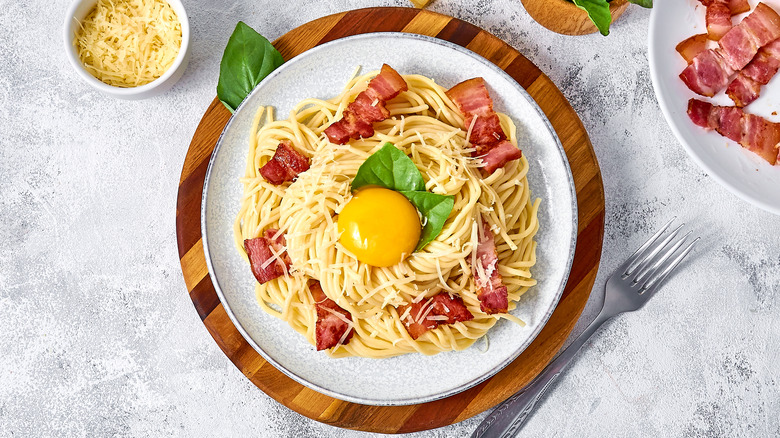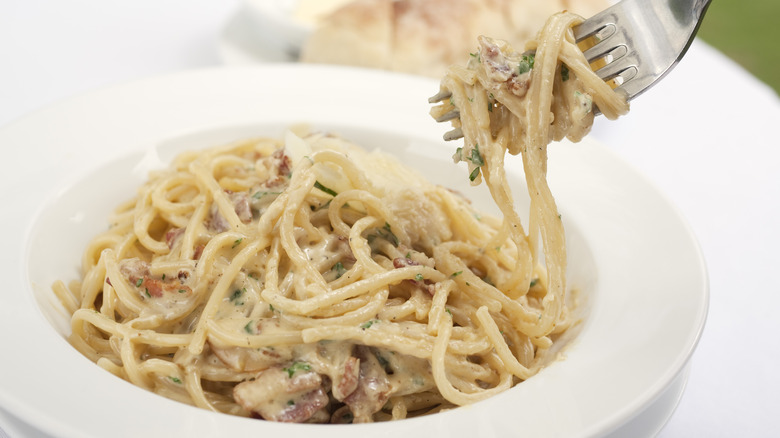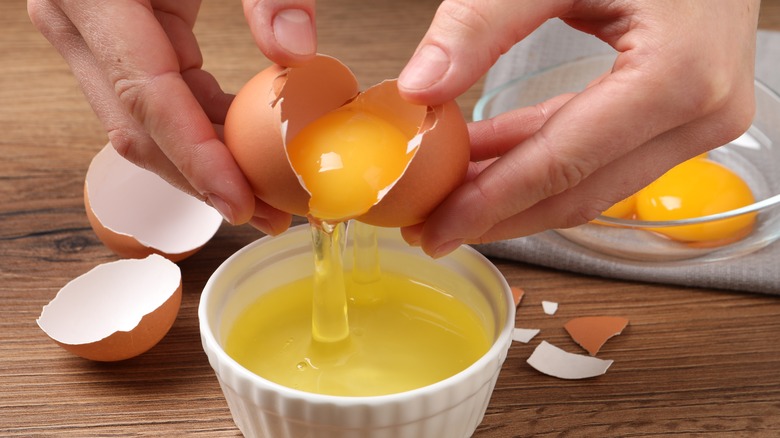Egg Yolks Are Your Secret Weapon Ingredient For Silky Pasta
Eggs and pasta might not seem like a natural match in your mind, but if you have ever had Roman-style spaghetti alla carbonara, you have experienced the magic that happens when these two meet. For a creamy, dreamy plate of pasta, you don't need to travel to Rome, and you don't need to track down a package of guanciale — but you do need an egg and an open mind.
You probably already have an egg on hand and some familiarity with their infinite versatility, which lends to everything from a simple plate of scrambled eggs at breakfast to a souffle for dessert. They also happen to be the secret ingredient for elevating pasta — all you need to do is crack a yolk over the finished dish just before serving to coat it in a golden glow of silky sauce worthy of a Michelin star. This single ingredient has a dual effect, acting as a flavor enhancer thanks to the rich taste of the yolk while also layering a buttery texture to every bite.
How to make your creamy pasta dreams come true
To start, all you need is your favorite pasta shape, be it fusilli, farfalle, or fettuccine. If it's your first time making eggy pasta, don't worry about adding in a whole lot else — keeping it simple will demonstrate the ease and effectiveness of this trick. Cook your pasta as you normally would, but before you drain it, pour some of the hot starchy water into a bowl and set it aside. Once you have plated your pasta, make a concave space in the middle of the dish, pour in a small amount of the pasta water, then add in an egg yolk and stir it all together until it thoroughly covers all the pasta pieces.
As with the process of making mayonnaise or a hollandaise sauce, the yolk acts as an emulsifier. A protein called lecithin found in the colorful center of an egg becomes smooth and creamy when mixed together with a liquid (in this case, starchy pasta water). Add a sprinkle of cheese a la carbonara, a few chopped fresh herbs of your choice (parsley or oregano are safe, delicious bets), or your favorite seasoning blend — black pepper alone works, but get creative! Toss in a little Old Bay seasoning mix or some jambalaya spices for a unique silky, creamy sauce.
Temperature tricks for separating and safely using your eggs
There are a couple of reasons to pay attention to temperature during this particular pasta-making process. First, you'll want to set your egg out for a while before preparing your meal since it's easier to separate eggs at room temperature.
It is also important to note that the Center for Disease Control and Prevention warns that raw eggs can cause foodborne illnesses and that some people are more at-risk than others, including children, adults over the age of 65, and those with weak immune systems. Eggs that are not cooked to 160 degrees Fahrenheit may be contaminated with salmonella, a harmful bacteria. A 2020 study published in LWT – Food Science and Technology demonstrated that pasta dishes made with raw egg (specifically spaghetti alla carbonara) could contain traces of salmonella.
To avoid any gastrointestinal distress, use pasteurized eggs — which have been heated to a high temperature to kill bacteria — when preparing pasta in this way. You can also temper your eggs and cook the sauce thoroughly in your pan to ensure everything is thoroughly heated.



